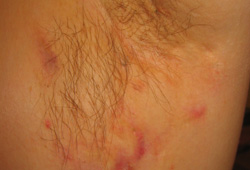Resumo
Definição
História e exame físico
Principais fatores diagnósticos
- presença de fatores de risco
- doença recorrente
- resposta insatisfatória à antibioticoterapia prévia
- comedões abertos nas áreas intertriginosas (axila, virilha, períneo ou região inframamária)
- nódulos ou abscesso
- distribuição simétrica
- tratos sinusais com cicatrização
Outros fatores diagnósticos
- piora pré-menstrual
Fatores de risco
- obesidade
- sexo feminino
- tabagismo
- história familiar positiva
- Afro-americanos
Investigações diagnósticas
Investigações a serem consideradas
- cultura bacteriana
- biópsia de pele
Algoritmo de tratamento
abscesso agudo
leve (estágio I de Hurley)
moderada (estágio II de Hurley)
grave (estágio III de Hurley)
Colaboradores
Autores
David Cassarino, MD, PhD
Consultant Dermatopathologist
Southern California Permanente Medical Group
Los Angeles Medical Center
Los Angeles
CA
Declarações
DC declares that he has no competing interests.
Agradecimentos
Dr David Cassarino would like to gratefully acknowledge Dr Robert A. Lee, the previous contributor to this topic.
RAL declares that he has no competing interests.
Revisores
David R. Adams, MD, PharmD
Associate Professor of Dermatology
Penn State Hershey Medical Center
Hershey
PA
Declarações
DRA declares that he has no competing interests.
Ravi Ubriani, MD, FAAD
Assistant Professor of Clinical Dermatology
Columbia University
New York
NY
Declarações
RU declares that he has no competing interests.
Andrew Carmichael, MB, BS
Consultant Dermatologist
James Cook University Hospital
Middlesbrough
UK
Declarações
AC declares that he has no competing interests.
Créditos aos pareceristas
Os tópicos do BMJ Best Practice são constantemente atualizados, seguindo os desenvolvimentos das evidências e das diretrizes. Os pareceristas aqui listados revisaram o conteúdo pelo menos uma vez durante a história do tópico.
Declarações
As afiliações e declarações dos pareceristas referem--se ao momento da revisão.
Referências
Principais artigos
Kim WB, Sibbald RG, Hu H, et al. Clinical features and patient outcomes of hidradenitis suppurativa: a cross-sectional retrospective study. J Cutan Med Surg. 2016;20:52-57.Texto completo Resumo
Martorell A, García-Martínez FJ, Jiménez-Gallo D, et al. An update on hidradenitis suppurativa (part I): epidemiology, clinical aspects, and definition of disease severity. Actas Dermosifiliogr. 2015;106:703-715.Texto completo Resumo
Sabat R, Jemec GBE, Matusiak Ł, et al. Hidradenitis suppurativa. Nat Rev Dis Primers. 2020 Mar 12;6(1):18. Resumo
Martorell A, García FJ, Jiménez-Gallo D, et al. Update on hidradenitis suppurativa (part II): treatment. Actas Dermosifiliogr. 2015;106:716-724.Texto completo Resumo
Kimball AB, Okun MM, Williams DA, et al. Two phase 3 trials of adalimumab for hidradenitis suppurativa. N Engl J Med. 2016;375:422-34.Texto completo Resumo
Ingram JR, Woo PN, Chua SL, et al. Interventions for hidradenitis suppurativa. Cochrane Database Syst Rev. 2015;(10):CD010081.Texto completo Resumo
Artigos de referência
Uma lista completa das fontes referenciadas neste tópico está disponível para os usuários com acesso total ao BMJ Best Practice.

Diagnósticos diferenciais
- Acne vulgar
- Doença de Crohn
- Psoríase inversa
Mais Diagnósticos diferenciaisDiretrizes
- North American clinical management guidelines for hidradenitis suppurativa part II: Topical, intralesional, and systemic medical management
- Guidelines for the management of hidradenitis suppurativa (acne inversa)
Mais DiretrizesConectar-se ou assinar para acessar todo o BMJ Best Practice
O uso deste conteúdo está sujeito ao nosso aviso legal